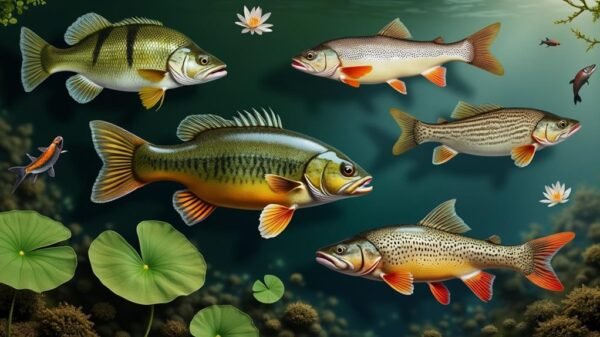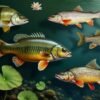Understanding freshwater fish throughout history reveals their pivotal role in ecosystems and human culture. These fish contribute to food webs while showcasing unique adaptations across species. Key characteristics, like body shape and color, help you identify them in their habitats, whether in rivers, lakes, or streams. Popular species, such as bass and trout, attract anglers and offer exhilarating experiences. Historically, fishing has shaped communities, economies, and culinary traditions, connecting people across generations. By appreciating this history, you'll gain insight into the delicate balance of aquatic environments and the lasting significance of freshwater fish. There's so much more to explore!
Freshwater Fish Overview
Freshwater fish form a crucial component of aquatic ecosystems and human culture. These remarkable organisms play an essential role in sustaining the balance of their environments. They inhabit rivers, lakes, and ponds, contributing to the aquatic food web and supporting various wildlife species. Freshwater fish can be categorized by water temperature, influencing their behaviors and habitat preferences, such as adaptations found in coldwater species like salmon or trout. Each species exhibits unique traits that enable them to thrive in freshwater habitats.
Understanding freshwater fish is not limited to anglers or aquatic biologists; it is for anyone who appreciates nature and the chance to explore it. Observing these fish in their natural environments can be profoundly rewarding. You will discover how they interact with their ecosystems and one another, forming a vibrant underwater community.
If you have an interest in fishing or maintaining an aquarium, it is vital to understand the various species and their specific needs. Begin by researching local fish populations; this awareness will enhance your appreciation of their ecological roles. You will improve your fishing techniques and foster a deeper connection with nature. Dive into the world of freshwater fish, and let your curiosity lead you through this captivating realm.
Identifying Key Characteristics

When examining various species of freshwater fish, distinct characteristics emerge that help in their identification. These traits enhance appreciation for the diversity found in aquatic life. First, observe their body forms. Some fish exhibit elongated, slender physiques, while others possess robust, round bodies. For example, popular freshwater game fish like Largemouth Bass showcase a stout shape, which aligns with their predatory habits, influencing their swimming techniques and preferred environments.
Next, analyze the hues and patterns displayed on their scales. Vibrant colors often signify species that inhabit clear waters, whereas muted shades may indicate fish that camouflage among rocks or aquatic plants. Additionally, pay attention to their fins and tails. The dimensions and configurations of these appendages can provide insights into a fish's speed and agility within its aquatic habitat.
Popular Freshwater Fish Species

Many anglers and nature lovers pursue popular freshwater fish species that provide both thrill and challenge. Bass, especially largemouth and smallmouth varieties, are prime targets. These fish are known for their aggressive nature and deliver an adrenaline rush upon being hooked. They rank among the most abundant fish species worldwide, making them a staple for freshwater fishing enthusiasts. Additionally, they inhabit lakes, rivers, and ponds, ensuring accessibility for many anglers.
Trout is another popular choice. Whether casting lines in mountain streams or tranquil lakes, catching rainbow or brook trout can be incredibly satisfying. They're not just fun to catch; they also make for a tasty meal. This species is particularly cherished in North America for river and lake fishing, continually drawing numerous fishing aficionados.
Catfish, identifiable by their whiskered faces, appeal to night fishing enthusiasts. As bottom feeders, they often seek out deeper waters. When targeting catfish, it's essential to use bait that matches their palate.
Lastly, panfish such as bluegill and crappie are ideal for novice anglers. With their abundance and ease of capture, they make for perfect family fishing outings.
Habitats and Environmental Factors

In various ecosystems, the comprehension of habitats and environmental factors that affect freshwater fish species is essential for productive angling. Freshwater fish inhabit diverse environments, including rivers, lakes, and streams, each presenting distinctive conditions. For instance, angling in lakes and ponds can yield a diverse fishing experience, as these water bodies often host various fish species like Largemouth Bass, Rainbow Trout, and Channel Catfish. It is important to monitor water temperature, clarity, and flow rate. Some species, such as Brook Trout, prefer cooler waters, while others, like Bluegill, thrive in warmer conditions.
The habitat structure significantly influences fish behavior. Regions featuring rocks, aquatic plants, or submerged logs offer shelter and spawning grounds. Fish often conceal themselves in these areas, waiting for the opportune moment to ambush prey or evade predators. Employing techniques such as using bait that mimics natural prey, like Berkley PowerBait, can enhance your chances of success in these habitats.
Additionally, consider the impact of pollution and human activities on water quality. Clean water is vital for fish health and reproduction. When you fish, reflect on how your actions influence the environment and the sustainability of these aquatic ecosystems.
Historical Significance of Fishing

Fishing has held a crucial position in human history, influencing cultures and economies for thousands of years. This ancient practice was among the first methods used to obtain nourishment. It united communities, strengthening ties among families and tribes. The techniques required for fishing were handed down through generations, creating a rich heritage that continues today. In the United States, the variety of freshwater species, such as largemouth bass and trout, showcases the diverse habitats and traditions that have emerged around these fish.
In various cultures, fishing transcended mere sustenance; it became a means to engage with nature and find tranquility on the water. Imagine casting your line into a serene lake—it offers a moment of solace in our hectic lives. The array of methods and tools developed over time highlights human ingenuity and adaptability.
Additionally, fishing has had a profound impact on local economies. It sustains livelihoods, boosts tourism, and inspires regional culinary traditions. By recognizing the historical significance of fishing, one can appreciate its integral role in the tapestry of societies worldwide. Whether you are reeling in a trout for a meal or spending a day by the water, remember that you are participating in a long and vibrant legacy that honors our bond with nature and one another.



























